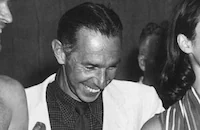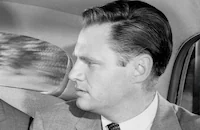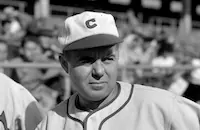Civilian electronics contractor Dave Brewster (Adam Williams) arrives at a top-secret missile complex behind security gates in a canyon just off a California beach. His family is housed with other civilian employees in a row of trailers, also on the base. The Brewster boys Bud and Ken (Michel Ray of The Brave One & Johnny Crawford of The Rifleman) make contact with a glowing "thing" in a beachside cave, which soon has seven youngsters doing its bidding. Young Tim Gamble (Johnny Washbrook) resists at first, but the group leader Bud entreats him to surrender his will. The other kids, including cheerful Eadie Johnson (Sandy Descher, the lost girl from Them!) recognize the thing as non-threatening, and happily follow its instructions. Growing until it begins to resemble an illuminated super-brain, the thing commands the group of kids to disobey their parents and break into the research center, where the military is preparing to launch The Thunderer, a multi-warhead nuclear satellite. Even some of the scientists, including Dr. Wahrman (Raymond Bailey) doubt the wisdom of this passive-aggressive form of satellite warfare. Using the thing's super-powers, Bud and his friends can unlock chained gates, disable vehicles and walk undetected past security police. They telepathically prevent Dave Brewster from reporting what he knows. Wahrman witnesses the kids infiltrating the launch complex, but can do nothing to stop them. Why are the children so happy to be destroying their country's missile defense system? And what are the brain-thing's real aims?
A matinee favorite for its completely unexpected anti-militarist theme, The Space Children is an engaging but thoroughly confused bit of liberal message filmmaking. Producer William Alland had spent the better part of a decade helping to invent Universal Pictures' wave of 1950s Sci-fi hits, including the impressive 3D classics It Came from Outer Space and Creat ure from the Black Lagoon, directed by Jack Arnold. Alland moved to a better deal at Paramount, only to find himself given even smaller budgets to produce two more Universal-style fantasies. Alland's deal at Paramount did allow him more freedom to choose his scripts. Jack Arnold had exited the Universal series in 1955, but returned because he liked the offbeat story idea.
The Space Children's pacifist attitude appealed to film critics, especially those in Great Britain where the Ban the Bomb movement was already underway. The repetition of the words "on the beach" several times in the dialogue, and occasional morose statements about the missile project seem quite purposeful. Although not entirely successful with his child actors, Alland stretches his limited resources to produce a simplistic but satisfying result. Seen in retrospect, the film's message seems rather garbled. The alien brain-thing is ostensibly working to achieve its positive mission "through the essential innocence of the children", but what we see is something else. The kids seem happy, yet are compelled to obey the brain's orders. No dissent is allowed. The little gang of conspirators maintains constant telepathic contact with each other, much like John Wyndham's menacing "Midwich Cuckoos" children of Village of the Damned. Whatever the purpose, surrendering one's psychological liberty to an alien entity doesn't sound good to these ears. Although the movie eventually implies that the brain might be an Angel from heaven, there's little difference between being brainwashed by this noggin from space, and falling under the influence of an espionage agent, child molester or Manson-type cult guru.
An interesting aspect of The Space Children is its depiction of a gulf between the kids and their conventional, clueless parents. The love and concern of Mr. and Mrs. Brewster is expressed mostly in commands and mild fits of temper, while the brain-thing gives the children a sense of security and purpose. It's more than a little disturbing when Bud and Ken disobey their father -- and then silence him out of loyalty to their new master. Other parents, like Hank Johnson (jackie Coogan) remain aloof to the conspiracy, but the thing in the cave protects Tim from his drunken and abusive father (Russell Johnson), providing the film's one scene of outright violence.
The movie seems hip to the new reality of life in the military-industrial complex. With the military and aerospace hiring boom happening in California during the 1950s arms buildup, proper housing could not always be found. Mrs. Brewster (Peggy Webber) registers disappointment to find that her family is going to be living in a tiny trailer on a patch of dirt overlooking a featureless beach. The impression given is that the arms race is turning civilians like Mrs. Webber into nomads, and America into an armed camp. Released only a few months after the launch of the USSR's Sputnik 1, The Space Children takes a mild yet undeniable anti-government point of view: it sees American militarism as a grave threat to world peace.
Director Arnold directs fairly smoothly considering that real windblown California coastline exteriors (Point Dume?) don't cut well with interior sets of the trailer park and the beach cave. When one of the kids jumps from the real rocks he throws just one shadow, and when he lands in the full-lit studio set, he suddenly has three shadows. All of the rocket installation exteriors are filmed on the Paramount Lot in Hollywood. The kids sneak through the security gate off Van Ness Avenue -- what is that full civilian neighborhood doing in the middle of this remote security zone? Instead of the sheer cliffs of the canyon surrounding the missile site as depicted in several matte paintings, the skyline shows the palm trees separating the Paramount lot from the Hollywood Forever Memorial Cemetery.
The most alarming theme in classic '50s space-oriented films is the notion, repeated again and again in dialogue, that the real goal of the American rocket program is to put nuclear weapons in orbit, to "insure the peace" by seizing the high ground in the Cold War. The Space Children depicts a mad race to beat the Russians (and the Czechs?) to the draw. Curiously, the sabotage plan to destroy The Thunderer involves blowing up its warhead -- which one would think would scatter the highly fissionable material in its hydrogen bombs to the four winds. Does the brain from space intend to save us by irradiating the entire West Coast of the United States?
The show concludes in a rather facile standoff between adults and children, followed by a
Bible quotation written in formal calligraphy that reinforces an earlier dialogue clue about
an, 'angel from heaven'. Unfortunately, the confirmation of this undigested religious angle
aligns the gentle The Space Children with two crackpot Sci-fi thrillers that also mix
Cold War jitters with religious sentiment -- 1952's Red Planet Mars and 1957's The 27th Day.
I've already invoked a tenuous link to the malevolent gang of kids in Village of the
Damned --- that movie's pacifist follow-up Children of the Damned is probably
closer in spirit. With all that radiation floating around the California shoreline, maybe the
Space Children can hole up in that cave and become highly radioactive themselves.... and this
show can segue directly into Joseph Losey's These are the Damned For casual fans of '60s television, The Space
Children will be an opportunity to see Gilligan's Professor (Russell Johnson), Uncle
Fester Adams (Jackie Coogan) and Mr. Drysdale of The Beverly Hillbillies (Raymond
Bailey) all in one movie!
Olive Films' Blu-ray of The Space Children is a sharp HD transfer of this B&W film; a
standard DVD is available as well. A moderate amount of dirt and speckling doesn't detract
from the overall presentation. Scarcely seventy minutes long, the show displays Paramount's
high production values, and quality cinematography by Ernest Laszlo. Jack Arnold's desolate
beach settings are no less eerie than his forbidding desert-scapes for Alland's Universal
Sci-fi series.
The disc includes no extras. The specialty label Olive Films is currently releasing The
Space Children's original double bill co-feature, The Colossus of New York on
Blu-ray as well.
For more information about The Space Children, visit Olive Films.
by Glenn Erickson























